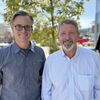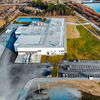Processing Your Payment
Please do not leave this page until complete. This can take a few moments.
- News
-
Editions
View Digital Editions
Biweekly Issues
- December 15, 2025
- December 1, 2025
- Nov. 17, 2025
- November 03, 2025
- October 20, 2025
- October 6, 2025
- + More
Special Editions
- Lists
- Viewpoints
-
Our Events
Event Info
Award Honorees
- Calendar
- Biz Marketplace
FIRST PERSON: Conscientious development | In the process of acquiring choice real estate in Casco Bay, a Portland nonprofit balances development with conservation
-Francis Hodgson Burnett, 1849-1974
Years ago, growing up in Cape Elizabeth, I had the opportunity to explore Casco Bay with a friend and his family on their boat. We stopped and had a picnic lunch on an abandoned island. It was not like anything I had ever seen ˆ pristine sandy beaches, tropical-seeming trees (that I now know as sumacs) and the remnants of an old World War I army facility, Fort Lyons. It was every kid's dream: wild, mysterious and adventure-inviting. This place of wonder was Cow Island, a 26-acre ocean outpost rich in varied topography, maritime history and uncommon vegetation such as cow parsnip, striped maples and native leeks.
For nearly three decades I have retreated to Cow Island as a safe place to relax, recreate and ruminate. For most of those 30 years I never imagined being involved in the purchase and transformation of this extraordinary seafarer's respite. However, six years ago, the idea of acquiring and creating a campus for environmental and experiential studies began to flicker incessantly.
In September of 1998 I created a team to kayak the length of the eastern seaboard, from Maine to Florida, in an effort to alert youth in America that there are two types of risky behavior: acceptable and unacceptable. In May 1999, a team of six left Lubec; 212 days later, two of us finished our sea sojourn 2,600 nautical miles later in Key West, having met with nearly 3,000 youth. Rippleffect was born.
Upon the successful completion of our benefit paddle, Aaron Frederick and myself, acting as trustees/founders of the fledging organization Rippleffect, began another expedition. We were hunting for real estate in which to base our youth programs. Rippleffect, with its broadened mission ˆ to promote positive youth development through learning adventures in living classrooms ˆ was certain of only one thing: It needed to be near the ocean.
Aaron and I had half-joked about buying Cow Island when (and if) we returned from our journey down the coast, but it always seemed a bit beyond our reach. A mere three miles from Portland but in the heart of Casco Bay's inner islands, with its considerable size and a picture perfect cove, Cow Island, we thought, would make for an ideal base camp. The existing buildings on the island ˆ Battery Bayard, a 2,500 sq. ft. facility with eight offices and two interior rooms; Battery Abbott, consisting of two bunkers; and what we refer to as the western power station, a 2,500-square-foot facility that formerly housed the island's generator ˆ were icing on the cake.
As fate would have it, in the winter of 2001, a close friend of mine and a supporter of Rippleffect suggested we contact the owner of Cow Island. My friend was under the impression it was to be put up for sale by late spring. He indicated I should call the owner immediately.
When I called the owner, my initial request that he make a gift of the island to our organization was gently rebuffed; he had a partner and needed to recover some of his investment. Fair enough, I thought. I asked if we could meet to discus the price and terms; given our mutual friend and our compelling plans for the island, he agreed.
Terms of the deal
After chatting for some time at his beautiful coastal home, ultimately the owner agreed: Turning Cow Island into an ocean outpost for area kids to learn in a safe place, do meaningful work and be in the comfort of caring adults would be good for the area. He offered generous terms ˆ he would assign us an exclusive, 60-day option at the height of the selling season. At or before the 60 days we had to surrender $500,000 (33% of the cost of the island, which was listed for $1.5 million).
We gratefully accepted, feeling the terms were fair and the price below market. However, 60 days to raise $500,000 was a stretch, and those payments afterwards would be difficult for some months. Overnight, we assembled a team of 20 professionals and began dialing for dollars.
In early June, nearly the 11th hour in our efforts to purchase Cow Island, Maine Coast Heritage Trust stepped forward. Its mission is to protect land in Maine for future generations to enjoy in perpetuity. Typically, the organization spearheads land acquisition projects and lends guidance to smaller local trusts. MCHT holds conservation easements, which legally bind landowners to terms favorable to the public. We had approached them about helping us acquire Cow Island; they agreed this was an important project, since keeping this land undeveloped was of highest priority.
MCHT indicated the value of the island would be considerably less with the restrictions that would be created by a conservation easement. However, the organization agreed to contribute to the purchase. Then, MCHT went one step further, buying the island outright upon closing June 15, 2001. The organization agreed to hold the island safely until we could recover the remaining dollars, which were Rippleffect's responsibility. In addition the seller, at the closing, agreed to make a major gift toward the purchase, lowering handsomely the price to both organizations' benefit. When the smoke clears, Rippleffect and MCHT will have shouldered the financial investment nearly equally. The deadline for the exchange of the money for the deed is Dec. 31, 2004. There remains some fundraising to be done.
The jigsaw puzzle
Three years after launching this ambitious effort, Aaron and I continue to be alternately energized and consumed by the project. What began as a volunteer-led group is now a stable organization that employs more than 30 field staff in the summer and maintains a year-round team of seven professionals. During the summer of 2001 we delivered services to 90 area teens, the next year 335 and last year more than 550. Although our season is not yet complete, we anticipate topping 600 individual participants in our programs this year.
One of our most recent challenges has been designing a master development plan for Cow Island ˆ an irony, since our goal, and that of many stakeholders, is that the island remain essentially undeveloped. But in order for Rippleffect to provide services that are safe, as well as to allow for anticipated growth and an expansion of services to include the general public, we needed to transform the existing bunkers and batteries and build a few small buildings.
The jigsaw puzzle was to reconcile how one could create a year-round facility for a private school and summer programs on an island, allowing for no more than 30 students and 10 staff at a time, while also allowing the general public to access, explore and recreate on the property in perpetuity without either group diminishing the experience of the other. In addition, any new construction ˆ the draft conservation easement allows for only a caretaker's cottage, two bunkhouses and a picnic pavilion ˆ could not be "prominently seen from seaward," according to the easement.
Infrastructure such as water and power were also of great concern. Presently, no water or power is available on the island, unless you count one small generator and Poland Spring six-gallon jugs. Since one of Rippleffect's priorities is to teach conservation values, we are hesitant to introduce these amenities from the grid. However, they could ease our delivery of services and make the island experience more comfortable, allowing us to attract more youth. There again lies the conundrum ˆ comfort, at what sacrifice to values?
Last spring, knowing the details of the conservation easement needed to be concluded, we gathered 30 important stakeholders together to wrap our brains around Rippleffect's mission and programs in the context of this dynamic yet fragile resource, Cow Island. Participants ranged in age from 24-68; some were artists, others were engineers, teachers and business folks. Many were islanders and more than a few were environmentalists, one a singer-songwriter. The goal was to pull a truly diverse group together in the hopes that by brainstorming, building upon one another's ideas and compromising, ultimately the best idea will emerge. And it did.
The three "charettes" (problem-solving idea shops) took place last summer. The first explored the limitations and concerns, as laid out by the easement and design issues as detailed above. Many voices emerged, presenting a constellation of conservation and environmental values and beliefs. Since Rippleffect subscribes to and teaches "leave no trace" ethics, it was helpful to understand that those values presented a baseline we could all agree on. (LNT encourages stewardship, including tenets such as camping on durable surfaces, leaving what you find, minimizing campfires, respecting wildlife, etc.) We all agreed that public access, which both MCHT and Rippleffect held as an important value, presented both an opportunity (to share) and challenge (to share).
Non sibi sed omnibus
The second charette was an opportunity for folks to throw out ideas about what they'd like to see Cow Island look like if there were no financial, geographic, safety or other limitations. Topics ranging from power sources, materials to be used for construction, a trail network and camp sites to the maximum number of visitors allowed at a time and the location of new buildings were discussed at length. For example, the boundary line between public and private land need to be clear, so that our students were not to be disturbed at any time. Fences, it was agreed, seemed like a bad idea; simple signage would be better.
The third charette synthesized these ideas and allowed for a presentation of agreed-upon conclusions. Keeping the new buildings near or within the confines of Battery Bayard, an area the size of a football field with a natural ledge berm to one side, an 11-foot cement wall to another side and a concrete building to seaward made up of eight officers' rooms and two large interior spaces, was believed to be important. Changing from two bunkhouses to three (the aggregate square area not exceeding the originally agreed-upon 1,200 sq. ft.) also made sense, since we would likely never have an even split of boys to girls and overflow of one group could go in the third bunkhouse. Coed housing was ruled out as unwise for obvious reasons.
The caretaker's cottage, everyone agreed ˆ especially the caretaker ˆ should be near Battery Bayard, but not within that tight space. Our caretaker, Eliza Adams, her husband and eight-year-old twin boys live on the island from early June through August. Privacy and comfort was considered a high priority if we were going to be able to continue to attract quality caretakers. The cottage site also should allow for seasonal breezes since, as we all know too well, summers in Maine are humid.
Everyone agreed the existing buildings should not be included in the public domain as a right, but rather a privilege; we can allow folks to visit when those areas aren't in use, but restrict access when our students are on island. This precaution will ensure that our students have an undisturbed experience, as on any school campus. This arrangement works to everyone's advantage since we do not run weekend programs and the public mostly visits the island on the weekends. Our insurance agent also appreciated this detail.
So far, we have implemented several of these ideas, including creation of an organic garden and installation of a spectacular composting toilet that both fits our values ˆ it uses green energy, was located on an existing foundation and was placed so it can't be seen from seaward ˆ and eliminates the need to transport full portapotties across Casco Bay at the end of each season. Next, we'll start work on the adaptive renovation of Battery Bayard and the construction of the bunkhouses. There's much more detail on the development plan in a 40-page booklet to be available on our website, www.rippleffect.net, but at least through this narrative one can surmise that great care went into making good decisions that ultimately will, we believe, stand the test of time.
A sign atop Douglas Mountain in Sebago states non sibi sed omnibus (not for one but for all). Immediately upon seeing this inclusive Latin phrase, I felt it summed up our efforts, both in saving Cow Island from imminent development and in creating a place where we all ˆ generations of Maine families and visitors ˆ will be able to relax, reflect and ruminate on our lives.
Mainebiz web partners

The Giving Guide
The Giving Guide helps nonprofits have the opportunity to showcase and differentiate their organizations so that businesses better understand how they can contribute to a nonprofit’s mission and work.
Learn More
Work for ME
Work for ME is a workforce development tool to help Maine’s employers target Maine’s emerging workforce. Work for ME highlights each industry, its impact on Maine’s economy, the jobs available to entry-level workers, the training and education needed to get a career started.
Learn More
Groundbreaking Maine
Whether you’re a developer, financer, architect, or industry enthusiast, Groundbreaking Maine is crafted to be your go-to source for valuable insights in Maine’s real estate and construction community.
Learn more-
The Giving Guide
The Giving Guide helps nonprofits have the opportunity to showcase and differentiate their organizations so that businesses better understand how they can contribute to a nonprofit’s mission and work.
-
Work for ME
Work for ME is a workforce development tool to help Maine’s employers target Maine’s emerging workforce. Work for ME highlights each industry, its impact on Maine’s economy, the jobs available to entry-level workers, the training and education needed to get a career started.
-
Groundbreaking Maine
Whether you’re a developer, financer, architect, or industry enthusiast, Groundbreaking Maine is crafted to be your go-to source for valuable insights in Maine’s real estate and construction community.
ABOUT
NEW ENGLAND BUSINESS MEDIA SITES
No articles left
Get access now
In order to use this feature, we need some information from you. You can also login or register for a free account.
By clicking submit you are agreeing to our cookie usage and Privacy Policy
Already have an account? Login
Already have an account? Login
Want to create an account? Register
Get access now
In order to use this feature, we need some information from you. You can also login or register for a free account.
By clicking submit you are agreeing to our cookie usage and Privacy Policy
Already have an account? Login
Already have an account? Login
Want to create an account? Register







Comments